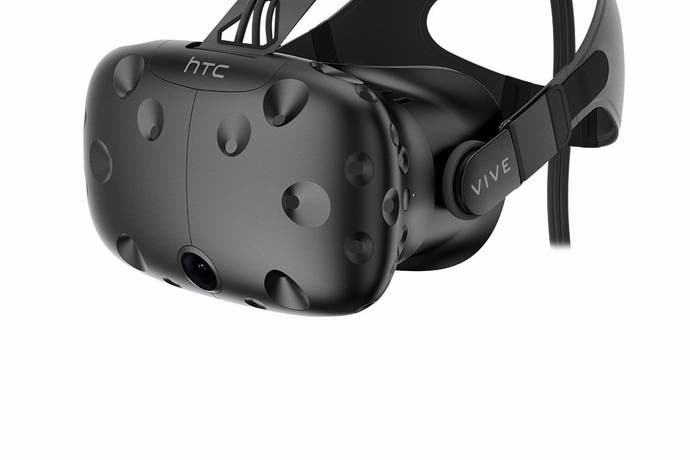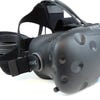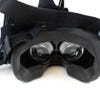HTC Vive review
A whole new world.
One of the big strengths of Oculus Rift is its plug-and-play simplicity. Put the camera sensor on the desk, plug in the cables and one simple calibration later you're good to go. There's a certain level of simplicity to it, tempered only by the nagging feeling that the product's feature-set just isn't complete. HTC Vive is the hardcore enthusiast's choice. It's not so easy to set up - you'll be drilling holes in the walls to get the base station mounting brackets into optimal position - and there are cables to content with. Lots of cables. Oh and three power supplies. And a breakout box.
The Vive package offers up an initial wow factor, for sure. The box itself is about the same size as a tower PC, and opening it up reveals the headset, base stations and controllers in secure foam surrounds. But there's more - a side-package contains the Vive's breakout box, while underneath the base station you'll find the mass of cables, power adapters and chargers. Side-by-side with the Rift, you can't help but feel that you're getting a lot of additional value from your extra $200. Those beautiful, futuristic controllers stand out immediately - this is the full package.
But the bottom line is that while HTC Vive offers the premium, top-end virtual reality experience, you have to work for it. Digital Foundry's landlords won't take too kindly to us drilling holes in the walls, so right now we have the base stations sat on desktop tripods, positioned precariously on top of stacked cardboard boxes. Ideally, this duo of highly accurate positional trackers should be mounted around 30cm above head height, pointing down into the play space. We tried lighting tripods, but found that the lack of tilt severely cut into the viewable tracking area. On top of that, there are further practical issues. Each base station has its own power supply, so ideally you need power points located on each side of the room. We don't, so let's just say that the cabling is a bit of a nightmare. We also note that the base stations are running all the time they are plugged in - even if your PC is shut down.
The notion of functionality over form factor extends to the headset too, where three substantial, thick cables are bonded together, all of which connect to the breakout box, which in turn connects to your PC (more cables). And then there are more cables to contend with as you plug in a 3.5mm stereo plug from your headphones into the loose receiving socket on the HMD itself. At this point, the Rift's lighter weight, easy to handle cables and integrated audio really make it seem like an altogether more refined, better-designed solution - until you put the headset on.
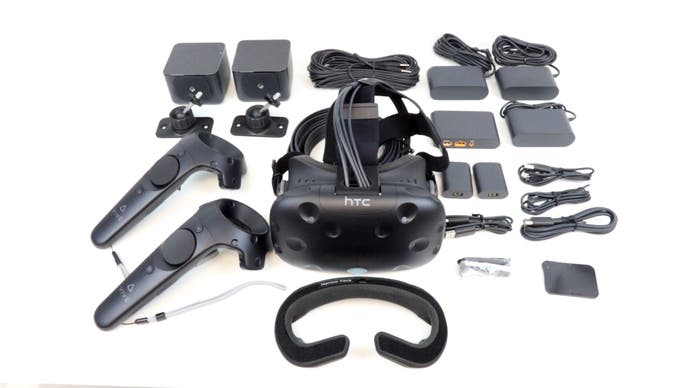
For those who wear glasses, there's no doubt that Vive is significantly more comfortable, with more space for wider or larger spectacles. The light leakage found from the bridge of the nose and the bottom of the Rift is absent on Vive, presenting a more immersive experience. The all-important field of view is also noticeably wider, though the 'screen door' effect of jumbo pixels right in front of your eyes is more noticeable - not distractingly so, but the individual sub-pixels are discernible when you focus on them. The overall impression is soft, but the scope of the image is immensely expansive. In terms of immersion, Vive is simply best in class.
The headset's front-mounted camera works brilliantly too. At any point, a double-tap of the system button on the 3D controller brings up the camera view, meaning you have easy access to the 'real world' from within the HMD. On top of that, the Vive's chaperone system - presenting a holodeck-style grid that defines the borders of the playspace - can also be adapted to integrate an outline of the real world based on the camera input. It provides a reassuring sense of place and real world positioning you don't get with the Rift - and it's essential really, as mobility is so important to Valve's take on VR, and you'll often find yourself in danger of bumping into the limits of the playspace.
All of this is explained to you at the tail-end of the set-up procedure, a charming VR vignette taking the form of an Aperture Sciences demonstration from a Portal droid as he guides you around your calibrated area. Beyond that, you're propelled into the SteamVR interface - which is, to all intents and purposes, an adapted VR rendition of Steam's Big Picture mode. Just like Oculus Home, this presents as a fully integrated console-style front-end - all levels of functionality are present and easily navigable, and there are some genuinely useful touches, like the ability to filter your VR library between static and room-space experiences.
But there is the sense that this is a VR extension of Steam as it stands right now, as opposed to the more curated finish of Oculus Home. As long as you meet the minimum spec requirements, almost every Oculus title boots up and just works. SteamVR is more akin to PC gaming as it is now - there's a general adherence to the i5/GTX 970 minimum spec combo set out by Oculus, but you are more likely to be required to fiddle with settings to get the best experience. Elite Dangerous even requires you to 'turn on' VR mode, even when you boot the game from SteamVR - an oversight the developer tells me will be corrected shortly. But the key advantage SteamVR has is, well, Steam. Oculus Home is cool, but do I really need another storefront on my PC, alongside the other five?
Going into this review, I was curious to see the extent to which Vive could match and perhaps even surpass the Rift on its own turf, not just offering room-space showcases, but also in offering seated play. However, it's very difficult to offer any conclusions on this right now - barring one or two titles, there's virtually no overlap between the two systems' launch catalogues.
However, what is apparent is that base station placement is crucial, even in a seated configuration - the issue here is that a desk and a high backed chair can cause occlusion issues in tracking. As good as they are, the base stations don't have x-ray vision. Again, the stations will need to be mounted quite high, pointing down, with a good view of the area. Oculus gets away with this to a certain extent because with the lack of 3D controllers, it only needs to track the headset, easily visible simply by resting the sensor on your desk. Vive needs to see more to track the controllers too, meaning careful set-up is required.
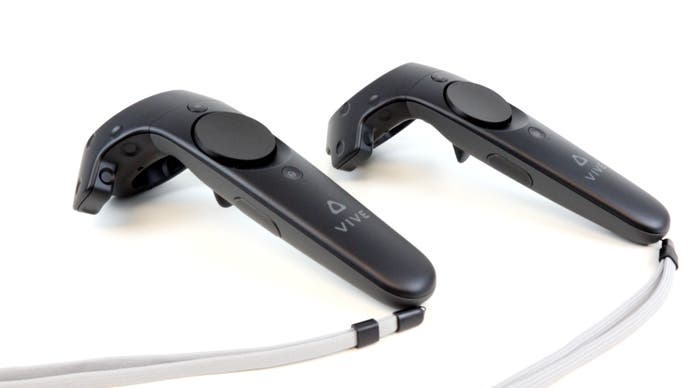
The end result of a VR catalogue split between the two competing systems is an almost entirely different experience, with little common ground between the two. Oculus takes existing game concepts and revitalises them with the sheer sense of scale and immersion that VR provides, while offering a tantalising preview of next-gen media support. SteamVR's focus right now is mostly on room-space - smaller-scale titles built from the ground up for VR, but reliant on mobility within the play area.
The minimum recommended space is 2m x 1.6m, though we managed to up this to around 2.5m x 2.1m in the Digital Foundry office. It still doesn't quite feel large enough to be honest, the chaperone system often kicking in with perimeter warnings as you generally tend to 'drift' around the area until you stray close to the edges. Many games scale fairly well within different spaces, but some require a lot of area to work properly. The Cubicle's 2.6m2 requirement looks onerous, but that's not a patch on Unseen Diplomacy's 4m x 3m minimum. Also beware of the height requirement too - smashes in SelfieTennis saw us hit the ceiling. Thankfully, Steam does warn you if a game's requirements exceed your calibrated area, but you can press on regardless. Unseen Diplomacy actually looks very, very cool - but the chaperone system was constantly active as we tried to play it. It could be a little frustrating to invest so much money in a Vive set-up only to find that you physically cannot properly play some of the games.
All of which brings to mind memories of Kinect, and the fact that many users were locked out of that experience owing to the lack of space. In this respect, Vive faces a challenge on two fronts - first of all, space clearly is an issue in getting the most out of the hardware. And secondly, the lounge really is the best venue for Vive, unless you have a spare room available in which to set up your VR cave. And by extension this has repercussions for the kind of PC you're likely to tolerate in the living room. We'd imagine you'd want something relatively small and discrete, as opposed to a monstrous desktop.
The bottom line is this - to get the best out of the Vive and SteamVR as it stands right now, there's a lot preparation, set-up and prerequisites to accommodate - and the configuration doesn't lend itself particularly to portability between rooms. It's hard to imagine that the full set-up in all of its glory could be housed in the average games room, office or bedroom, while the hard split in title availability between the two competing platforms makes it really difficult to assess Vive in terms of the seated experience in the way we could with Oculus Rift.
But the pay-off when you do have Vive set-up in optimal conditions remains utterly fabulous. The collection of mini-games and demos found in Valve's own offering - The Lab - is like a distillation of all of the phenomenal press demos the firm has carried out over the last 14 months. It's a melting pot of concepts and ideas that totally sells the sense of scale VR offers, and the sheer level of immersion, along with the way that even the most established gameplay concepts feel fresh and new again.
Key to the experience are the 3D controllers, effectively the manifestation of your hands in the VR world. Imagine a phaser-shaped PlayStation Move with a similar trigger system, paired with side 'grip' buttons plus a highly responsive circular trackpad (that doubles up as four face buttons). Tracking accuracy and latency are simply superb on all aspects of the design. The lion's share of titles use these devices, and the scope of their utility cannot be under-estimated. We'd recommend checking out Owlchemy Labs' Job Simulator as a great starting point for your VR library - it may not have much in the way of a replay factor, but not only is it a great deal of fun, it's a wonderful showcase for the flexibility and intuitive nature of the controller. You feel connected to the VR world through the controller because everything just works the way you feel it should.
The Vive headset offers up best-in-class immersion, but it's the controllers that serve up the gameplay. Final Approach, a beautifully realised VR take on Flight Control has you reaching up to pluck aircraft out of the sky, guiding them in to land. Cloudlands: VR Minigolf provides a stylised, fantastic world paired with eerily accurate physics - the controller works just like a golf club. Even less visually ambitious titles like Light Repair Team #4 - a simple game that's about positioning mirrors to redirect beams of light - prove absorbing, entirely by virtue of the interface. The list goes on. Virtually every Vive title demonstrates just how much 3D controllers are required for VR gaming. Without them you are more spectator than active participant. Also, the haptic feedback system borders on the uncanny - brush your 'hands' across the keyboard in Unseen Diplomacy and feel is quite remarkable.
The controllers also provide another key mechanic - pointing. Oculus Home has you moving your head in the direction of the option you want to select and pressing a button to make your choice. Steam's VR interface uses the altogether more satisfying, simpler method of point and click. In terms of gameplay, The Lab's Xortex and Longbow mini-games showcase this to great effect, along with the intense Space Pirate Trainer VR and Hover Junkers - VR's first online competitive first-person shooter. It's not out yet, but at the SteamVR developer conference, I had a lot of fun with Arizona Sunshine - Virtua Cop vs Resident Evil presented in pristine VR.
With some notable exceptions - Elite Dangerous being the most obvious example - there is the sense that the lion's share of SteamVR's offering is about smaller, concept-driven games, and it's clear that indie developers have an incredible tool here that really allows their imaginations to flourish. It's a shame that the full catalogue of VR titles isn't available yet, but there is a silver lining here - the vast majority of the games are tailored to Vive and its room-scaling mobility. The end result is that the disconnect between movement in the real world and VR is kept to a minimum - and that means far less nausea. Indeed, afternoon-long testing sessions went by with no problems. However, Elite Dangerous is the exception to the rule here, showing that the nausea issue will flare up in the same conditions on Vive as it does with Oculus Rift. It's just that these kinds of games aren't so prevalent in the line-up at the moment.
HTC Vive: the Digital Foundry verdict
Valve and HTC have worked together to provide the most comprehensive virtual reality solution on the market today, capable of astonishing results that pave the way in revolutionising the way we play games. However, living with the device for the past week has highlighted that as brilliant as it is, it is a first-gen product that demands a zero compromise approach that may cause issues for the average user.
You don't set up Vive so much as install it, the amount of space you'll need to get a satisfying experience is almost certain to require a fair amount of your living space, and the combined weight of headset, headphones and the constant presence of the intrusive cabling does feel a little onerous. On top of that, the system's credentials for seated experiences can't be fully tested right now because the vast majority of the available titles designed for that configuration reside on Oculus Home. Eventually, the exclusives on each platform will converge, but right now, the best Vive experiences are smaller, bite-sized chunks of gaming - brilliant to play in many respects and an irresistible taster of what is to come, but perhaps somewhat slight factoring in the money, time and space invested into putting a state-of-the-art VR system together.
And yet there's nothing quite like this. Load up any of the key Vive titles and it's like nothing you've experienced before. Gaming feels fresh, exciting, renewed - a giddy feeling after years of variations on the same themes. This is more than just a gimmick: it's an entirely new, blank canvas for developers to work with and it's already delivering some unique experiences. Clearly, it's not quite the finished article, but I can't wait to see how it develops.
